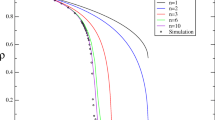Abstract
We present exact results for a lattice model of cluster growth in one dimension. The growth mechanism involves interface hopping and pairwise annihilation supplemented by spontaneous creation of the stable-phase, +1, regions by overturning the unstable-phase, −1, spins with probabilityp. For cluster coarsening at phase coexistence,p=0, the conventional structure-factor scaling applies. In this limit our model falls in the class of diffusion-limited reactions A+A → inert. The +1 cluster size grows diffusively, ∼√t, and the two-point correlation function obeys scaling. However, forp > 0, i.e., for the dynamics of formation of stable phase from unstable phase, we find that structure-factor scaling breaks down; the length scale associated with the size of the growing +1 clusters reflects only the short-distance properties of the two-point correlations.
Similar content being viewed by others
References
M. Scheucher and H. Spohn,J. Stat. Phys. 53:279 (1988).
B. Hede and V. Privman,J. Stat. Phys. 65:379 (1991).
P. Meakin, inPhase Transitions and Critical Phenomena, Vol. 12, C. Domb and J. L. Lebowitz, eds. (Academic Press, New York, 1988), p. 336.
J. D. Gunton, M. San Miguel, and P. S. Sahni, inPhase Transitions and Critical Phenomena, Vol. 8, C. Domb and J. L. Lebowitz, eds. (Academic Press, New York, 1983), p. 269.
V. Kuzovkov and E. Kotomin,Rep. Prog. Phys. 51:1479 (1988).
M. Bramson and D. Griffeath,Ann. Prob. 8:183 (1980).
D. C. Torney and H. M. McConnell,J. Phys. Chem. 87:1941 (1983).
Z. Racz,Phys. Rev. Lett. 55:1707 (1985).
A. A. Lushnikov,Phys. Lett. A 120:135 (1987).
M. Bramson and J. L. Lebowitz,Phys. Rev. Lett. 61:2397 (1988).
D. J. Balding and N. J. B. Green,Phys. Rev. A 40:4585 (1989).
J. W. Essam and D. Tanlakishani, inDisorder in Physical Systems, R. G. Grimmet and D. J. A. Welsh, eds. (Oxford University Press, 1990), p. 67.
J. G. Amar and F. Family,Phys. Rev. A 41:3258 (1990).
A. J. Bray,J. Phys. A 23:L67 (1990).
P. Clifford and A. Sudbury,Biometrika 60:581 (1973).
R. Holley and T. M. Liggett.Ann. Prob. 3:643 (1975).
J. T. Cox and D. Griffeath,Ann. Prob. 14:347 (1986).
Author information
Authors and Affiliations
Additional information
On leave of absence from Department of Physics, Clarkson University, Potsdam, New York 13699-5820.
Rights and permissions
About this article
Cite this article
Privman, V. Model of cluster growth and phase separation: Exact results in one dimension. J Stat Phys 69, 629–642 (1992). https://doi.org/10.1007/BF01050428
Received:
Issue Date:
DOI: https://doi.org/10.1007/BF01050428




